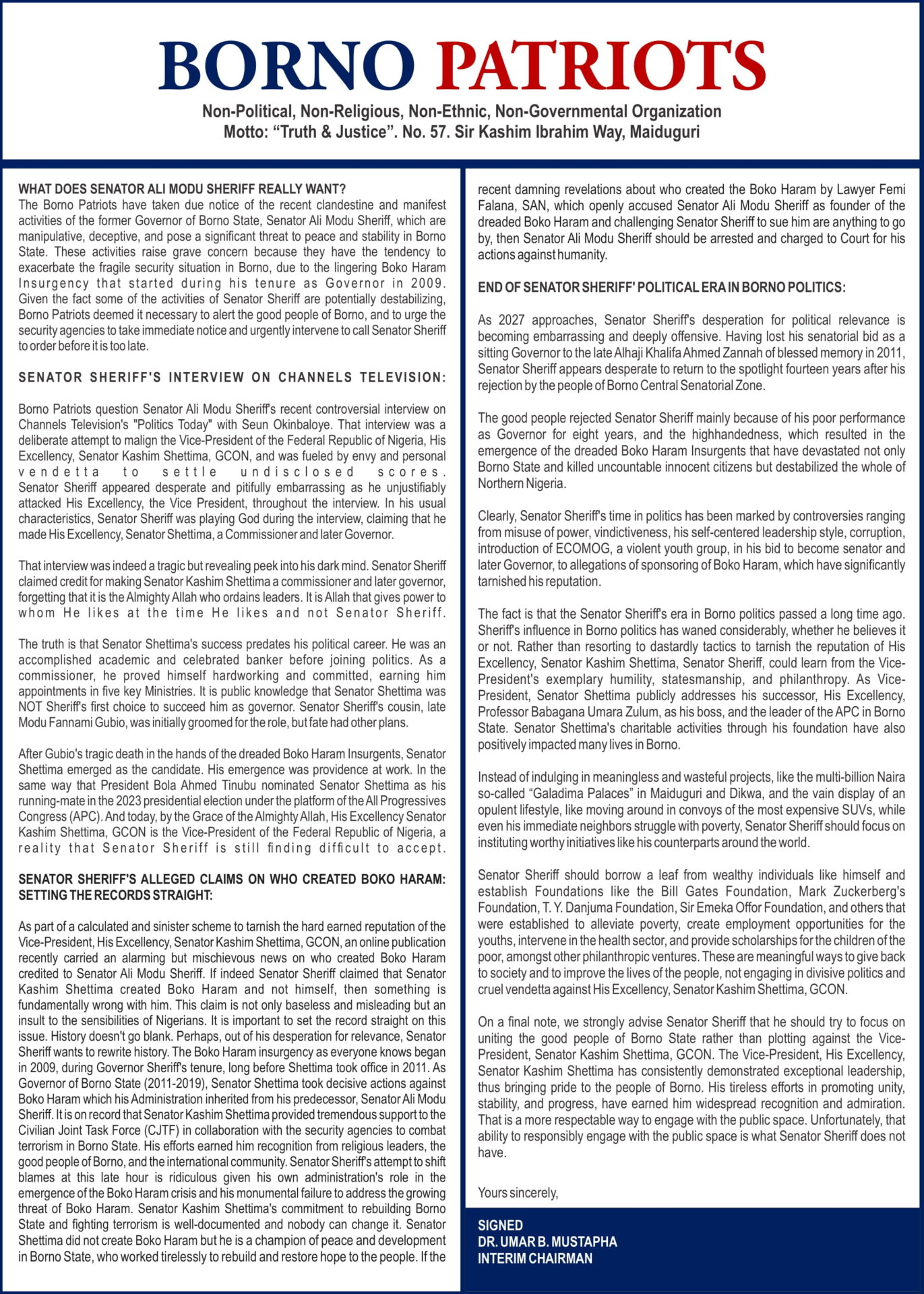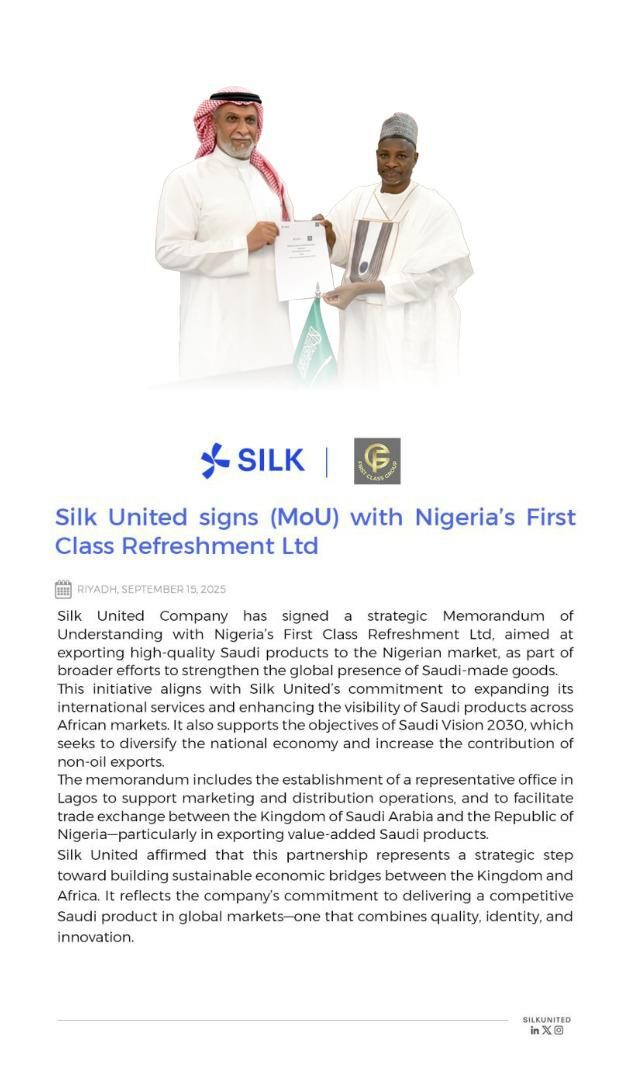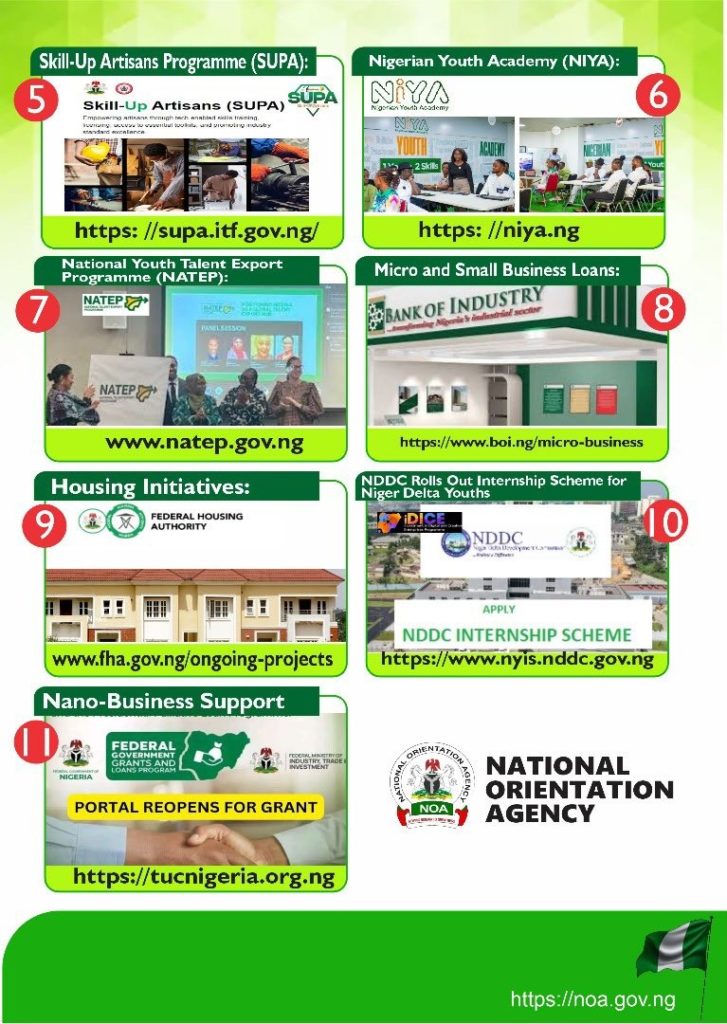‘Destruction of education and destruction of a country’
LET’S study this classic that most of us have received many times across platforms. It is on ‘why collapse of education is the collapse of a nation’.
Recall that the following words posted at the entrance gate of a South African university sums up the problems we are now facing:
“Destroying any nation does not require the use of atomic bombs or the use of long-range missiles. It only requires lowering the quality of education and allowing cheating in the examinations by the students”. The result is that:
“Patients die at the hands of doctors. Buildings collapse at the hands of engineers. Money is lost at the hands of economists and accountants. Humanity dies at the hands of religious scholars. Justice is lost at the hands of judges. Because “The collapse of education is the collapse of the nation.”
This message is not directed at President Bola Ahmed Tinubu and his Minister of Education alone. It is directed at all the 36 state governors and 774 local government council officials in this troubled federation. It is not about typing out the quotable quotes or words on marble on education in our various rooms and offices. It is about how our leaders can manage priorities in a way that will empower them to regard and invest in education as a weapon of country and global competitiveness.
This is not a time of lamentation about the quantum of time the ASUU members have wasted on strike, the only language authorities in Nigeria understand. It is not just a time to remember that ASUU has been the most unappreciated driving force behind improved remuneration package in the public sector.
It is just the right time to encourage our leaders at all levels to swallow their pride and vanity and be angry with themselves about the consequences of their violent ‘attack on education’ and indeed on the future of their country.
On reflection, they should know that without good and happy teachers, there won’t be good and employable graduates who can cope with the needs of the nation at this time.
Our leaders at all levels who like to decorate their bookshelves with the biography of Lee Kuan Yew, the Singaporean iconic leader who lifted his country from Third to First World when he led the country for 32 years, should read the remarkable autobiography of the legendary Yew.
Our leaders often appreciate orators and public speakers when they regale them with how Lee Kuan Yew turned around one city country to a significant nation. I would like to encourage our leaders to spare a weekend to study the role of quality not just in the education of Yew, but also in the life of Singaporeans. If they study the classics of the iconic Yew, they will see how education quality consciously funded as a fundamental objective of state policy, is the weapon the great leader used in developing his four million people then into global citizens, significant entrepreneurs, and great thinkers.
Interpretation:
Singapore’s power base is simple: intellectual capital. This can only be obtained through conscious and robust investment in education at all levels, not investment in big and expensive bridges and sport utility vans (SUVs) governors struggle to commission and use because our roads aren’t good enough. That is our first warning signal to them before it is too late.
The state of education and global competitiveness
The warning is germane now because the state of education anywhere is a combination of many factors, including the quantum of resources committed to the educational sector and the quality of human capital assigned to manage the value chain.
Nigeria has a long history with education. The country’s educational system has undergone transition from the traditional system where mature men instructed the youths in personal, good citizenship and community responsibilities to the formal Western education brought by the missionaries in the mid-nineteenth century.
Even before the 1960s schools were properly administered and discipline was enforced. The quality of graduates was high, and certificates awarded by the schools were equal to those awarded by schools in the West. However, things went sour and education was neglected in the late 1980s and the quality of graduates has since become unreliable.
This same degeneration has spread tentacles to the economy, governance, science and technology, medicine, religion, individual responsibility and finally Nigeria’s global competitiveness. Education quality drives global competitiveness.
According to Dike (2002), lack of funding, lack of teaching tools and modern classrooms, poor remuneration and “acute shortage of qualified teachers” contribute to the falling standard of education in Nigeria. About 2,015 primary schools are without buildings and classes are conducted under trees. However, mostly children of the poor who cannot afford good, but expensive, private schools attend these schools. What type of education would one receive under such a harsh condition?
Higher institutions haven’t been insulated from the malaise. Demand for higher education increased during the oil boom of the 1970s and the number of students increased without commensurate funding. In the 1990s, some of the loans from the World Bank for education were used to purchase irrelevant books and “expensive equipment” that could not be maintained.
It is a fact that the percentage of federal budgetary allocation to education has been dwindling. It was 7.2% in 1995 and 4.5% in 2004. The condition becomes more pathetic when Nigeria’s Gross National Product (GNP) allocation to education is compared with those of less affluent African nations that allocate greater percentage: Cote d’ Ivoire allocates 5% of its GNP to education, Kenya 6.5%, and Nigeria 0.76%.
Meanwhile, that fact that the primary school teachers have been largely unmotivated and secondary school leavers are unprepared for higher education, cultism and examination frauds have been rising in post-secondary schools. Consequently, even constant industrial actions as a result of poor funding and remuneration of teachers have also affected the quality of university graduates. Moreover, ranking of African universities in which Nigerian universities that were once highly rated are falling behind universities in poorer countries. A poor quality education is a reflection of bad government, as a good quality education is a reflection of good government.
Note this, the failure of the government to implement its 2009 agreement with university teachers prompted the strikes that haven’t abated. This agreement failure has exacerbated the mass exodus (‘brain-drain’) of experienced Professors to countries with better working conditions. Not much has changed because ASUU is still warming up for more strikes.
In this regard, where will internationalisation of higher education begin from?
Internationalisation of higher education and its global relevance
The internationalisation of university education has typically been seen as a contemporary trend driven by Western developed nations, whereby particular elite models of provision, most frequently delivered in the English language, are seen to have influenced global practice.
This trend has manifested itself in two main ways. First, through the recruitment of international students and academic staff, notably to the United States, Australia, the United Kingdom, and other Western countries.
Second, through the opening up by Western universities of branch campuses, typically now in collaboration with local institutions, in developing nations “overseas”.
The picture is, however, rather more complex than this. For a start, the internationalisation of higher education has been with us for centuries – indeed, arguably ever since institutions of higher learning were first established (De Ridder-Symoens, 1992) – though a quickening of pace with the massification of higher education in recent decades has to be acknowledged.
And there are also many other national and institutional players involved, not just Western universities and their partners. These operate in different ways at different levels, and with patterns varying between regions, nations, and institutions.
The term “globalisation” is often used in a similar way, indeed almost interchangeably, to internationalisation when discussing higher education policy and trends. Some authors, however, seek to make a distinction between the two, seeing internationalisation as a contemporary expression of internationalism, encompassing responses to the “forces” of globalisation, which are viewed as being far from benign in nature (Altbach & Knight, 2007; Dodds, 2008; Gacel-Ávila, 2005; Teichler, 2004). Here, we will stick to the term “internationalisation” where possible, while recognising the overlap.
How universities can promote internationalisation.
Those universities that work proactively in developing and sustaining international recruitment, networks, and strategies can expect their students to be more highly valued by multinational employers, who value a broadness of experience and intercultural awareness. Along with the teaching, research, and service staff, they will enjoy the opportunity to connect with talented students and faculty from peer universities around the world, and to make a contribution that is likely to be recognized on an international scale. This is what we call Internationalization: how can we make it work in today’s market?
One thing is for sure: teaching in English is a good start, but it no longer makes American institutions special. Across Europe and Asia, postsecondary institutions are keen to share in this culture of internationalised education and are already catering for local and overseas students. The UK, too, remains a prestigious destination for those who recognise the value of an English-language degree; education hubs such as Singapore and Malaysia, which can boast of English as an official or semi-official national language, are currently receiving substantial investment, and will be attractive prospects for Asian learners who might otherwise consider studying in the West.
Smart educators will resist getting overly caught up in the ebb and flow of today’s market, however. Internationalisation as a strategy for economic sustainability is neither a short-term nor an exclusive solution, but should rather form part of a culture of long-term investment that is as much about people and ideas as it is about revenue and filling classrooms.
That means opening up to partnerships and collaborations with international peers, investing in scholarships and student mobility, and nurturing less quantifiable values – excellence, innovation – as well as the figures that make it all function. While universities cannot and should not cast market concerns aside, all-out business strategies are neither culturally desirable nor economically sustainable in the higher education sector.
Students and graduates who seek international positions desire and benefit from a multicultural experience that more localised institutions cannot offer. For this reason, as much as those previously highlighted, universities that aspire to internationalisation will walk the walk as much as they talk the talk.
Thus, multiculturalism will be a keyword not just in the registry, but in the classroom, lab, support services, and online. Outreach programmes, conferences, and publications will extol the virtues of diversity, collaboration, and cooperation. When institutions can demonstrate that they are global in thought, culture, and ambition, the international talent they seek will find its way to their doors.
What else is the internationalization of higher education about?
Internationalisation has become an important issue in the development of higher education. Sven Groennings (1987) describes it as “one of the most powerful substantive development in the history of American higher education”.
This international dimension as an organised activity, referred to in general by the term “international education”, is a product of the 20th century introduced first mainly in the United States for reasons of foreign policy and national security.
Another argument is that around the end of the Cold War, this international dimension evolved into strategic processes, referred to as the “internationalisation of higher education” and became increasingly linked to globalisation and regionalisation of the societies and the impact of this on higher education.
It is further argued that with the development of globalisation, the international dimension will evolve into an integrated element of higher education and move away from its present position as an isolated set of activities, strategies and processes. This is manifested in a shift in emphasis from more traditional forms of international education to strategies that are more directly related to the core functions of the university, and in a shift in emphasis from political to economic rationales.
The implications of these shifts are the increasing importance of quality assessment of internationalisation strategies, the emergence of English as the common language of higher education, the increasing relevance of international networks and strategic alliance, and the gradual acceptance of the internationalisation of higher education as an area of research.
De Wit points out the need to relate the internationalisation of higher education in today’s world to the general roots of the university, and to place the present developments in historical perspective. His work (2002) makes a useful contribution to the unfolding of this phenomenon in the European and American higher education systems. Another study (De Wit et al., 2005) examined the internationalisation of higher education in the Latin American context.
Oloja is former editor of The Guardian newspaper and his column, Inside Stuff, runs on the back page of the newspaper on Sundays. The column appears on News Point Nigeria newspaper on Mondays.







